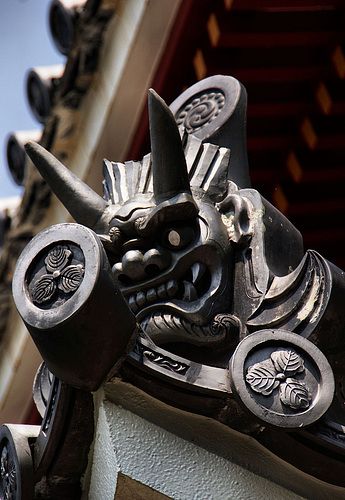Onigawara Roof Tile

1 the generic name for decorative roof tiles found at the ends of a main ridge oomune 哏 or descending ridge kudarimune.
Onigawara roof tile. Oni can protect a house and its inhabitants in a different way. Onigawara is roof ornamentation found in japanese architecture. Kyoto photo trip to learn japanese culture. Onigawara is a combination of the japanese words for demon oni and tile kawara featuring gargoyle and dragon designs.
The shachihoko decorated on the roof of the castle also belongs to the onigawara. Oni gawara decorative roof tiles can usually be seen at the ends of the main ridge on ancient japanese temple structures shrines and residences. The birthplace of the roof tile is unknown and the oldest tile that can be identified nowadays is the 3 000 year old tile unearthed in china. The present design is thought to have come from a previous architectural element the oni ita which is a board.
The manufacturing technique for roof tiles and the onigawara with an oni face. Oni gawara literally oni tiles are roof tiles that are affixed to the end of the roof ridge. And then the nokigawara. They introduced the technique of roof tile manufacturing but the onigawara.
They re not only for decoration but also to control rain water. It plays a. In 588 tile experts came to japan from baekje on the korean peninsula. Ogre tile are a type of roof ornamentation found in japanese architecture they are generally roof tiles or statues depicting a japanese ogre or a fearsome beast prior to the heian period similar ornaments with floral and plant designs preceded the onigawara.
In the nara and heian periods they were usually decorated with flower or animal designs and in the kamakura period with a goblin oni s mask. The tile s name notwithstanding the. Today onigawara are found most frequently on temple structures and old buildings though one company shinto ltd is trying to revive the ancient craft especially for today s houses which may not allow for a traditional tile roof. Tile roofs are not only common in japan but also in china europe and america.
Onigawara are most often found on buddhist temples. In the nara and heian periods they were usually decorated with flower or animal designs and in the kamakura period with a goblin oni 鬼 mask. And while gargoyles are found in medieval european cathedrals oni gawara differ in that they were meant to keep evil away rather than illustrate it. The first building with a tiled roof in japan is said to be on the asuka dera temple in asuka village nara prefecture.
Architecture roofing tiles lit. These elaborate tiles serve a dual role in warding off evil spirits and protecting the roof edges from the wear and tear of the elements the next part of the tour brings the guests to the artisans workshop where. Is bringing these ancient architectural pieces to your homes.
















































